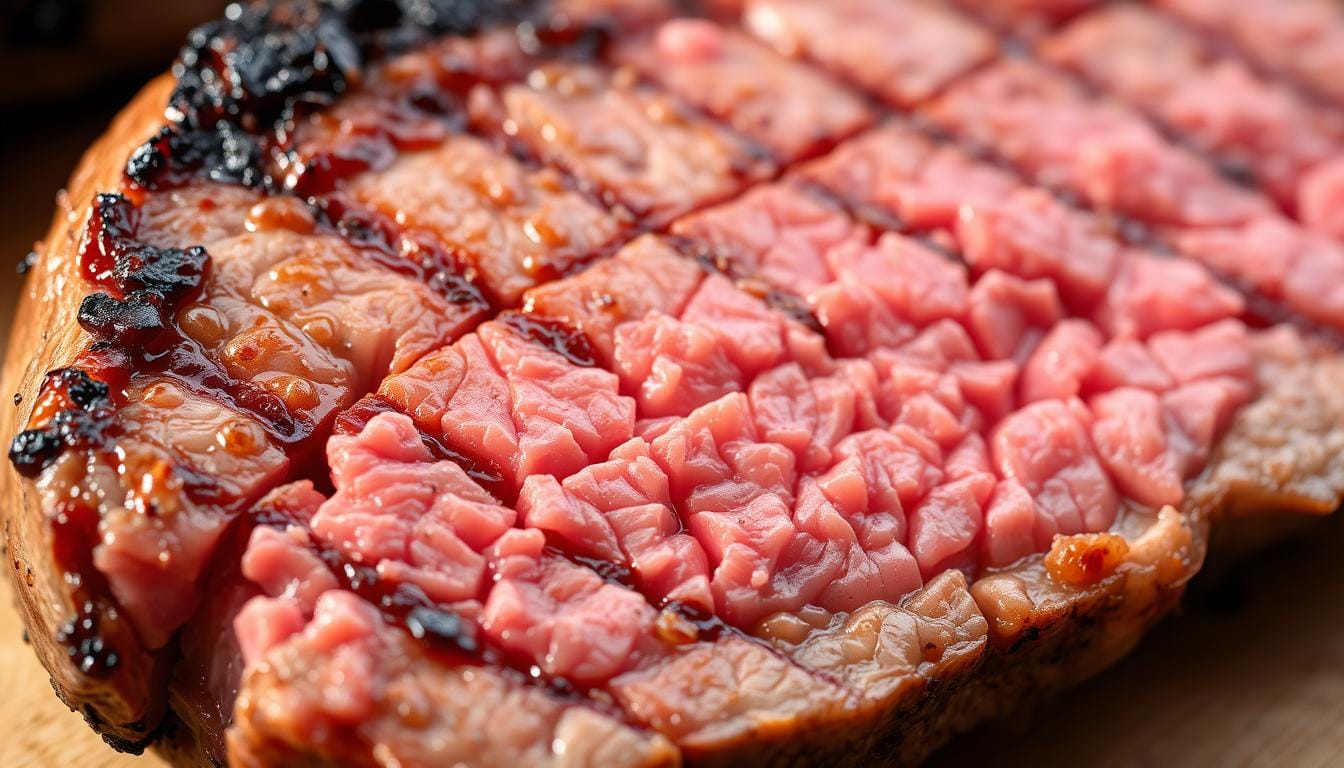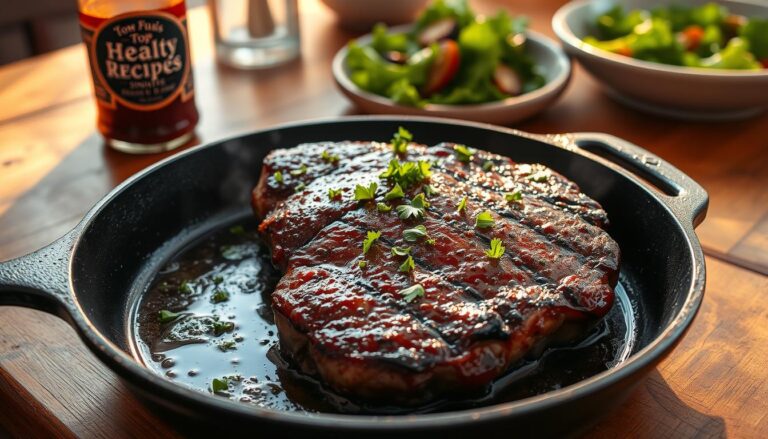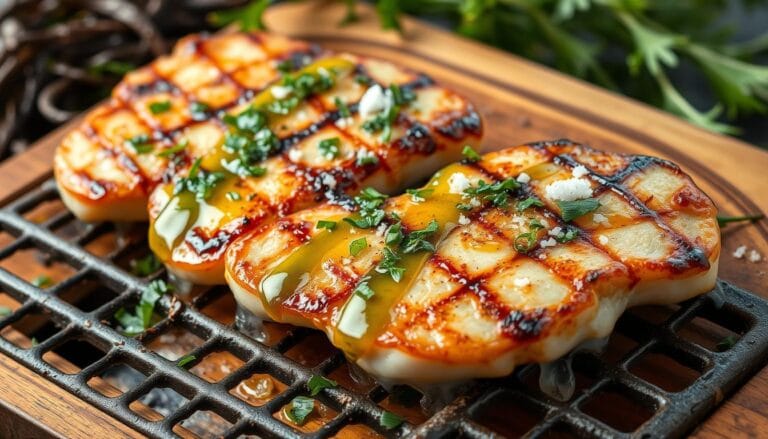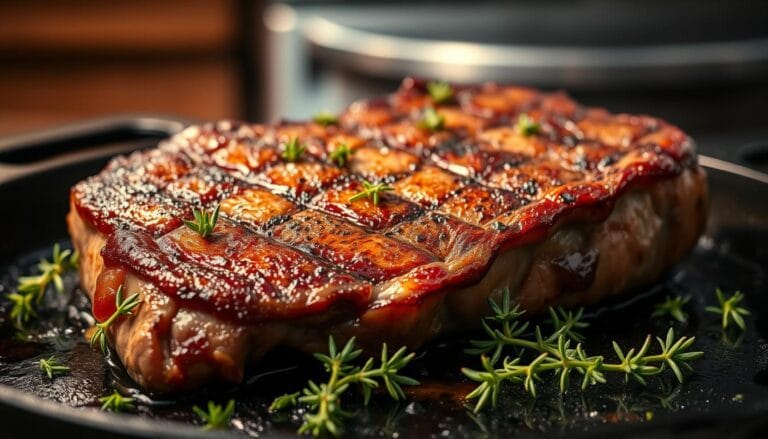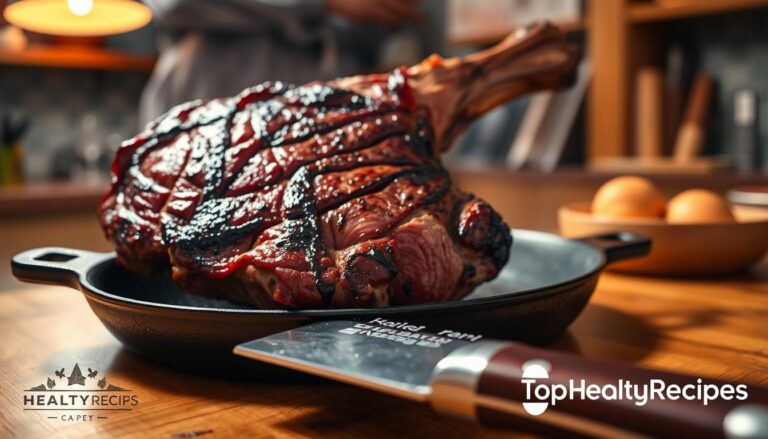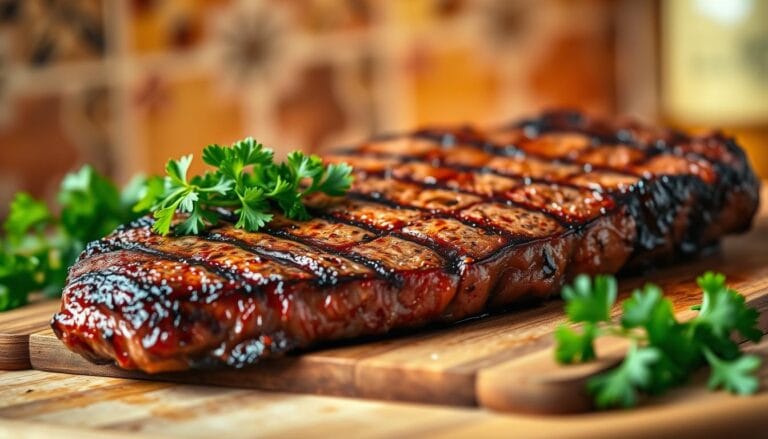What Temp Is Medium Steak? Nail That Perfect Pink Center!
Table of Contents
What Temp Is Medium Steak? Nail That Perfect Pink Center!
Getting the perfect medium rare steak is a dream for many. It’s about slicing into a juicy steak and finding that beautiful pink center. This experience makes any meal special, whether it’s for a big event or a simple dinner.
Mastering steak cooking is more than following a recipe. It’s about knowing the science behind cooking meat. When you succeed, you get a tender, flavorful, and delicious steak. In this guide, we’ll show you how to get that perfect medium rare steak temperature. You’ll impress your family and friends with your cooking skills every time.
Key Takeaways
- Understand the ideal internal temperature for a medium rare steak.
- Learn how to accurately measure the temperature of your steak.
- Discover techniques to achieve a consistently perfect medium rare steak.
- Explore tips for avoiding overcooked or undercooked steak.
- Improve your grilling and cooking skills for any occasion.
Understanding Steak Cooking Temperatures
Cooking a steak to the perfect medium rare isn’t just about tossing it on the grill or in a pan. It’s about understanding the science behind cooking temperatures. Getting the internal temp steak right is key for both flavor and food safety.
When you cook a steak, the internal temperature affects its protein structure, moisture, and flavor. As meat heats up, its proteins denature and contract, pushing out moisture. This is why overcooking by just a few degrees can make a juicy steak dry.
Why Steak Temperature Matters
Steak temperature matters for several reasons:
- Food safety: Undercooked meat can harbor harmful bacteria.
- Flavor: The right temperature enhances the natural flavors of the steak.
- Texture: Proper cooking ensures a tender and juicy texture.
Understanding these factors helps you see why precision is key when cooking steak to medium rare.
The Science Behind Cooking Meat
The science behind cooking meat involves heat transfer from the outside in. Factors like the steak’s thickness and its starting temperature affect how it cooks. Here’s a breakdown:
- Heat Transfer: Heat moves from the surface to the center of the steak. A higher heat can sear the outside quickly, locking in juices.
- Thickness: Thicker steaks take longer to cook and require more precise temperature control.
- Starting Temperature: Bringing your steak to room temperature before cooking can lead to more even cooking.
By grasping these concepts, you’ll be better equipped to achieve that perfect medium rare steak.
Ideal Temperature for Medium Rare Steak
Cooking a steak to medium rare needs careful temperature control. The internal temperature is key, helping you know when it’s just right.
The Perfect Target: 130°F to 135°F
The ideal temperature for a medium rare steak is 130°F to 135°F (54-57°C). This range gives you a warm red center and a firm edge. But, you must understand carryover cooking to hit this mark.
After taking your steak off the heat, its temperature will rise by about 5°F. This happens as the heat from the outside moves to the inside. So, take your steak off when it’s about 125°F (52°C) to account for this increase.
| Doneness | Internal Temperature | Description |
|---|---|---|
| Medium Rare | 130°F – 135°F | Warm red center, slightly firm exterior |
| Rare | 120°F – 130°F | Red center, soft exterior |
| Medium | 140°F – 145°F | Pink center, firm exterior |
Importance of Resting Time
Resting is a must for steak. It lets the juices spread evenly, making the steak juicy and flavorful. For most steaks, rest for 5-10 minutes. Thicker steaks might need a bit longer.
During rest, cover the steak loosely with foil. This keeps it warm without making the crust soggy.
“Resting your steak is just as important as cooking it to the right temperature. It’s the final step in achieving that perfect medium rare.”
With the right temperature and resting time, you’ll get a medium rare steak that’s just perfect.
Tools for Measuring Steak Temperature
Measuring the internal temp steak is key for a perfect medium rare. The right tool makes a big difference in getting your steak just right.
Instant-Read Thermometers
Instant-read thermometers are the top choice for steak temperature checks. They give a quick read when inserted into the steak’s thickest part. Choose models with thin probes to lose less juice and read fast (under 3 seconds). Digital versions are usually more precise than analog ones.
Wireless Meat Thermometers
Wireless meat thermometers add convenience by letting you check your steak’s temperature from your phone. They’re great for grilling or cooking many items at once. This way, you can keep an eye on your steak without opening the grill or oven door, keeping the cooking environment steady.
Thermocouples: Precision Cooking
Thermocouple thermometers are the top pick for serious steak lovers. They offer fast, accurate readings (often within ±0.7°F). Though pricier, they ensure you never guess the internal temp steak again.
Whichever tool you pick, make sure to place it right. Always check the center of the thickest part of the steak, avoiding fat or bones. With a good thermometer, you’ll cook steaks that are always perfect.
Visual Cues for Medium Rare Steak
While thermometers are accurate, learning to spot a medium rare steak by sight is key. A medium rare steak has certain looks and feels that set it apart. These signs help you tell it apart from other doneness levels.
Color: The Perfect Pink Center
The color of a medium rare steak is a big clue. It should have a warm red center that turns pink towards the edges. The outside should be brown. The color should blend smoothly, without a clear line between raw and cooked parts. The perfect pink center is a hallmark of a well-cooked medium rare steak.
Texture and Juiciness
The texture also tells you about the steak’s doneness. A medium rare steak feels firm but soft when pressed. It’s like the feel when you press the base of your thumb with your middle finger. Juiciness is another key indicator; it should release clear red juices when cut, not purple like rare meat or little juices like well-done.
Getting good at noticing these signs will boost your cooking confidence. It might even make you less dependent on thermometers. But, thermometers are the best way to get consistent results.
Methods for Cooking Medium Rare Steak
You can cook a medium rare steak in several ways, each with its own benefits. Each method has its own advantages for reaching the perfect medium rare temperature.
Grilling Techniques
Grilling is a favorite for steak, and it can make the steak taste great. To grill a medium rare steak, use a two-zone fire. High direct heat is for searing, and a cooler zone is for cooking.
For thicker steaks, try the reverse sear method. Start the steak in the cooler zone until it’s almost medium rare. Then, sear it quickly over high heat.
Pan-Searing Tips
Pan-searing is also great for cooking a medium rare steak. Use a heavy skillet, like cast iron, and preheat it very high. Add oil like grapeseed or avocado just before adding the steak.
Let the steak cook for 3-4 minutes before flipping. Add butter, garlic, and herbs in the last minute for extra flavor. Baste the steak with the butter for more taste.
Sous Vide Cooking Explained
Sous vide cooking is all about precision. It keeps your steak at 130°F in a water bath. Then, a quick sear finishes it off. This method prevents overcooking and ensures even cooking, but you need special equipment and it takes longer (1-2 hours).
| Cooking Method | Temperature Control | Flavor Profile |
|---|---|---|
| Grilling | High heat for searing, indirect heat for cooking | Smoky, charred flavor |
| Pan-Searing | High heat for searing, reduced heat for cooking | Rich, caramelized crust |
| Sous Vide | Precise temperature control | Consistent, tender texture |
Each method can help you get a perfect medium rare steak. Try different techniques to see what works best for you.
Selecting the Right Cut of Steak
Choosing the right steak cut is key to a perfect medium rare. Some cuts are better for medium rare than others. Knowing these differences can improve your steak cooking.
Popular Cuts for Medium Rare
Ribeye is great for medium rare because of its marbling. This makes it tender and flavorful. New York strip is tender and full of beefy taste at 130-135°F. Filet mignon stays moist and buttery at medium rare, but dries out quickly if overcooked.
T-bone and porterhouse steaks have both strip and tenderloin. They’re perfect for medium rare, giving you a tender filet and a flavorful strip in one.
Marbling and Flavor Considerations
Marbling, or the white fat in meat, adds flavor and juiciness. Beef with more marbling (Prime, Choice) can handle slight overcooking better. The fat also cooks faster, as it conducts heat well.
| Steak Cut | Marbling Level | Cooking Time |
|---|---|---|
| Ribeye | High | Fast |
| New York Strip | Medium | Moderate |
| Filet Mignon | Low | Slow |
Think about the steak’s thickness too. Thicker steaks (1.5-2 inches) are easier to cook to medium rare. Thinner steaks (under 1 inch) can be tricky.
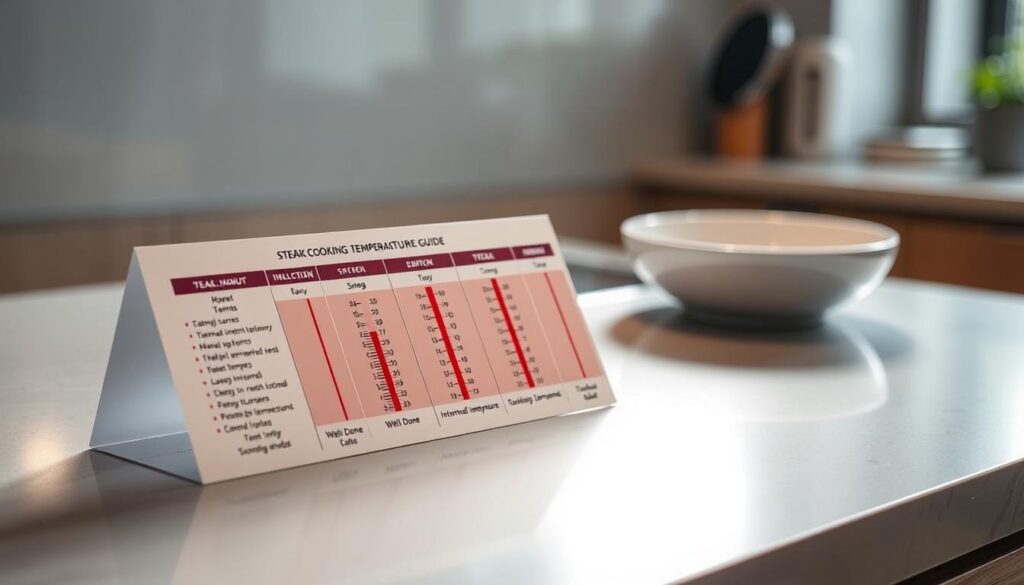
Preparing Your Steak for Cooking
Getting your steak ready right is key for a perfect medium rare. It involves several steps to cook it evenly and get the right taste and texture.
It’s not just about the temperature when cooking a steak. How you prepare it is also important. Good preparation helps you get that perfect medium rare.
Seasoning Essentials
First, pat your steak dry with paper towels. This helps create a good sear. If it’s wet, it won’t brown well.
For seasoning, keep it simple. Use kosher salt and black pepper. Season well, as most of the seasoning will stay on your plate.
For better flavor, try dry brining. Salt your steak 1-24 hours before cooking. Leave it uncovered in the fridge. This makes the meat taste better and feel nicer.
As Chef Gordon Ramsay says, “The quality of salt and pepper really matters for your steak’s taste.”
The Importance of Room Temperature
Make sure your steak is at room temperature before cooking. Take it out of the fridge 45-60 minutes before (30 minutes for thinner cuts). This helps it cook evenly.
A cold steak takes longer to cook. It might get overcooked on the outside before the inside is right. Room temperature steaks sear better, making a nice crust without overcooking the inside.
| Seasoning Method | Flavor Profile |
|---|---|
| Simple Salt and Pepper | Enhances natural flavors |
| Dry Brining | Deeper, more complex flavor |
| Marinades | Varied, depending on ingredients |
Cooking Time Guidelines
While temperature is key, cooking time helps plan your meal. It tells you when to check the steak’s temperature.
Factors That Influence Cooking Time
Several things affect how fast your steak cooks. Thickness is the biggest factor. A 1-inch steak cooks in 4-5 minutes per side over high heat. But a 2-inch steak takes 8-10 minutes per side.
The steak’s starting temperature also matters. A room-temperature steak cooks faster than a cold one. Your cooking method and heat level also play a big role. High-heat searing cooks the steak quicker than using moderate heat.
Estimating Cooking Time Based on Thickness
For a 1-inch thick steak at room temperature, here are some guidelines:
| Cooking Method | Cooking Time per Side |
|---|---|
| High-heat grilling or pan-searing | 3-4 minutes |
| Broiling | 4-5 minutes |
| Reverse searing | 15-20 minutes at low temperature followed by 1-2 minutes per side at high heat |
For each extra half-inch, add 2-3 minutes of cooking time per side. Keep in mind, these are just estimates. The exact heat, grill or pan material, and meat cut can change the timing.
“The key to cooking a great steak is not just about the heat, it’s about the timing and the technique.”
Resting Your Steak After Cooking
Resting your steak after cooking is as important as getting the internal temperature right. This step lets the juices spread out evenly. It makes your steak moist and full of flavor.
How Long to Let It Rest
The resting time for your steak depends on its thickness. For steaks that are 1-1.5 inches thick, rest for 5-7 minutes. Thicker steaks, 1.5-2 inches, need 8-10 minutes. Very thick cuts, like tomahawk ribeyes, might need 12-15 minutes.
- Average steaks (1-1.5 inches): 5-7 minutes
- Thicker steaks (1.5-2 inches): 8-10 minutes
- Very thick steaks: 12-15 minutes
Benefits of Resting
While resting, your steak’s internal temperature will rise by about 5°F. It’s best to remove it from heat when it’s 5°F below your target internal temp steak. This is usually around 125°F for medium rare.
To rest properly, place your steak on a warm plate or cutting board. Loosely cover it with aluminum foil. Don’t cut into it too soon.
This way, you’ll get a juicier, more flavorful medium rare steak. Resting is not just a pause. It’s a key step to perfect steak.
Troubleshooting Common Issues
Cooking a medium rare steak can be tricky, even for experts. Sometimes, your steak might not turn out right. Let’s look at common problems and how to fix them to get better results.
Overcooking Your Steak
Overcooking can make your steak too medium or medium-well. If it’s over 140°F, it’s likely too late for a medium rare. But, you can make it better with a sauce like béarnaise, chimichurri, or compound butter. They add moisture and flavor.
To avoid overcooking, check your cooking method. Maybe you’re using too much heat or cooking too long. A good thermometer can help you hit the right temperature.
Underseasoned Steaks
Underseasoning can ruin a perfectly cooked steak. It’s key to season more than you think. This way, you’ll have enough flavor left on the steak.
If your steak is underseasoned, use finishing salt like Maldon or fleur de sel before serving. It can boost the flavor.
For tough steaks, the problem might be the cut or how you slice it. Always cut against the grain for tenderness. If the crust is lacking, try drying the steak, using a hotter pan, or the reverse sear method.
Pairing Medium Rare Steak with Sides
After getting your steak to the perfect medium rare, think about what sides to add. A great steak is just the start of a fantastic meal.
Best Side Dishes to Complement Your Steak
Classic steakhouse sides are a comforting match for your medium rare steak. Try creamy mashed potatoes for a side that’s both comforting and pairs well with the steak’s flavor.
Roasted vegetables add a burst of flavor and texture. They work well with the steak’s rich taste. For something crispy, truffle fries or a fresh green salad with a tangy dressing are great choices.
Wine Pairings for Medium Rare
Choosing the right wine for your steak is key. A medium rare steak needs wines with good structure and body. Bold reds like Cabernet Sauvignon, from places like Napa Valley or Bordeaux, are perfect. They have tannins that match the steak’s proteins and fats well.
Malbec from Argentina is a fruitier option that works well with the steak’s richness. If you like something different, try a robust Syrah/Shiraz or a Super Tuscan blend. Even a full-bodied, oaked Chardonnay can pair well if you prefer white wine.
The secret to great pairing is balance. Your sides and wine should enhance the steak’s flavor and texture without overpowering it. This way, your perfectly cooked medium rare steak stays the main attraction.
Storing Leftover Medium Rare Steak
After enjoying your medium rare steak, you might wonder how to store leftovers. It’s important to cool the steak to room temperature within 2 hours. This helps prevent bacteria from growing.
Proper Cooling Techniques
To cool your steak, place it on a plate and cover it loosely with plastic wrap. Then, refrigerate it. This method keeps the steak fresh. Make sure not to wrap the steak too tightly, as it can make it soggy.
Here are some tips for cooling your steak:
- Cool to room temperature in 2 hours
- Use a plate for air circulation
- Loose plastic wrap to avoid moisture
Reheating Tips for Best Flavor
Reheating a medium rare steak can be tricky. Conventional methods might overcook it. For the best taste, use gentle reheating methods. Here are some ways to do it:
- Sous Vide Reheating: Seal the steak and heat it in a 130°F water bath for 30 minutes.
- Oven Reheating: Heat the steak in a 250°F oven until it’s about 110°F. Then, quickly sear it in a hot pan.
- No-Cook Option: Serve the steak cold or at room temperature. Slice it thinly for salads or sandwiches.
- Microwave Reheating: Reheat on 50% power in short intervals, checking often to avoid overcooking.
By following these tips, you can enjoy your medium rare steak even after it’s been stored. It will stay perfectly pink and full of flavor.
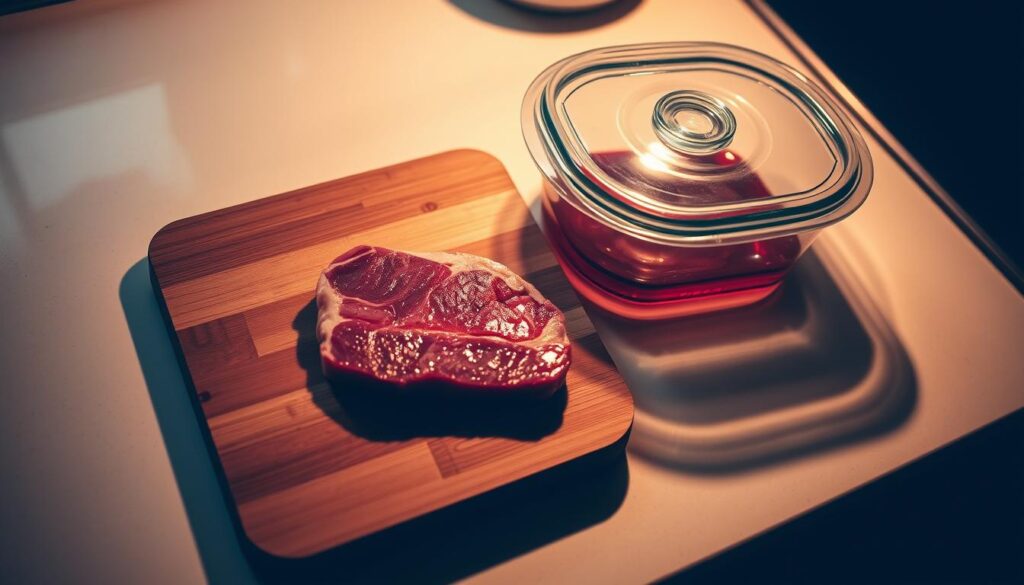
Final Tips for Perfect Medium Rare Steak
Keep working on your steak-cooking skills. Try new seasonings and marinades to boost the flavor. Compound butters with herbs or spices can enhance the taste without overwhelming it.
Flavor Enhancements
Try dry rubs with coffee or smoked paprika for a rich crust. But, be careful with marinades. Acidic ingredients can make the meat tough if marinated too long. Stick to 4 hours for the best taste and tenderness.
Practice Makes Perfect
Getting the perfect medium rare takes time and effort. Keep track of your cooking times and temperatures. With more practice, you’ll know exactly when your steak is just right, between 130°F to 135°F.
FAQ
What is the ideal internal temperature for a medium rare steak?
How do I measure the internal temperature of a steak?
What is carryover cooking, and how does it affect my steak?
How long should I let my steak rest after cooking?
What are some common issues when cooking medium rare steak, and how can I troubleshoot them?
How can I reheat leftover medium rare steak without overcooking it?
What are some recommended side dishes and wine pairings for medium rare steak?
How should I store leftover medium rare steak?
For more cooking tips, stay connected with us. We also recommend the cookbook Skinnytaste Simple: Easy, Healthy Recipes with 7 Ingredients or Fewer
For more Recipes about Steak ?
Did You try our recipe ?
There are no reviews yet. Be the first one to write one.
